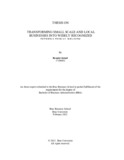| dc.description.abstract | The main goal of this study is to figure out how to keep a national local business going in foreign
markets. The more businesses do business all over the world, the more important it is for them to
make good decisions about how to turn national brands into global ones. Make sure you understand
the similarities and differences between branding in local and international markets so that you
can show that a national brand can compete in all kinds of markets around the world! The way to
make a national brand into a global one hasn't been studied much at all to this point, but that could
change. If you want to know how a national company gets into foreign markets, there are very few
studies that are more in-depth and only look at that. The main goal of this study is to come up with
a way to think about how a national business can move to another country. An investigation into
the field of international branding found out about the most important things that brands do in
foreign markets and how they are affected by them. If you want to build your international brand,
there are at least four stages: (1) branded product vs generic product, (2) manufacturer brand vs
private brand (3) single vs various brand (4) global brand vs. local brand, the most important thing
is to make people aware of the brand, then think about how the brand looks. The image is formed
by the brand's essential essence or positioning, which gives customers a unique extra value. The
methods used in the domestic market to strengthen the brand may not work in other markets. When
choosing an international brand, both internal and external factors should be taken into account.
Internal parts of the company also play a role in supplying. This group of factors focuses on the
following: how much money is spent on brand building, how much centralization there is in the
business, and how much money can be saved by cutting costs. When making an international
brand, it is important to think about the differences between domestic and international markets.
Consumer behavior, marketing infrastructure, competitive landscape, level of economic growth,
cultural values, and state regulation are all things that could be different in different markets, but
they aren't the only things. These differences could have a big impact on how the brand is formed
and managed outside of the United States. There is a new way to turn a national brand into an
international one that is based on theory. Situation analysis, brand decisions in foreign markets,
adapting brand identity roots and integrated brand communications, and monitoring brand success
in a market are all part of this model. When introducing a national brand to a foreign market, the
strategy outlined below will help the organization focus on making the brand work in the new
country. The quantitative research method was used to reach the research goal. It was important
for me to get data from both primary and secondary sources in order to do this research
quantitatively. It's done by talking to people, filling out questionnaires, and looking at things.
Secondary data comes from a wide range of publications, such as newspapers, business pieces,
and periodicals about internationalization. The study is based on numbers. This research method
allows me to write down my findings numerically and to include statistical data in my presentation.
The study used questionnaires to do a survey descriptive method. The sample size was 80 and
calculated in random sampling technique. By using regression analysis, the findings are presented
in the presentation section that will help you to understand the branding strategy of MAVEN
Apparels Ltd. The result of r=0.4931 shows the relationship between corporate branding strategy
and the competitive market. The conclusion shows the organizational ability of MAVEN Apparels
Ltd. and the recommendation part will give an idea of an effective corporate branding strategy to
enhance its business position in the international market. | en_US |

